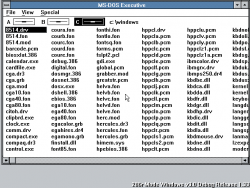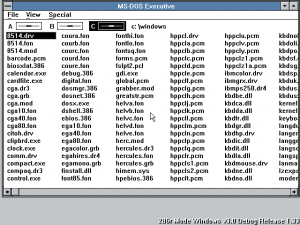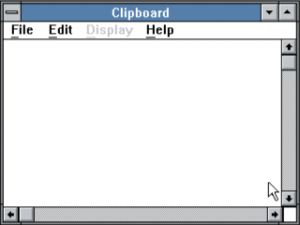 |
|
| Kernel version | 3.0 |
|---|---|
| CPU architecture | x86 |
| Compile date | 28th July 1989 |
Windows 3.0 build 33 is mentioned in Microsoft anti-trust document PX09006 from August 1989. According to the document, this build already had functional e-mail support and was very slow. This build was later shared online on 23rd September 2022.
Installation
As the available copy of this build does not have a setup executable, you must manually install this build. It is recommended to use a period-accurate version of MS-DOS from that time (e.g. COMPAQ MS-DOS 3.31/MS-DOS 4.01) for this.
On the hard disk, make a directory on the hard disk, then copy all the files from disks 1 through 5 to the same directory. Assuming the directory is C:\WINDOWS, edit CONFIG.SYS with the FASTARTS or EDLIN tool and add the following:
DEVICE=C:\WINDOWS\HIMEM.SYS
FILES=40
BUFFERS=40
Reboot the machine to finish installation.
Notable findings
Modes
This build is the earliest available build to add support for modes. There are 3 modes:
- 286r (real mode)
- 286p (standard mode)
- 386p (386 enhanced mode)
The R stands for x86 real mode, while the P stands for protected mode.
There is also no detection for each mode, so parameters have to be used in order to boot into each mode; e.g., win /3 or win /p will launch Windows in 386 enhanced mode. This is not the case with its real mode, as it can be boot up without any parameters.
Boot screen
This build features a modified Windows 1.x/2.x bootscreen with the Microsoft logo being replaced with Windows 3.0 text in the Helvetica Italic Black font, and the version information changed to simply say "We Believe in Magic!". The bootscreen is only shown in the 286r and 386p modes, as for an unknown reasons Windows skips the logo code in 286p mode.
Shortly after the boot screen appears, a debug warning will print on the screen. In the 286r mode, it immediately prints it, while in the 386p mode, it waits a few seconds and then prints the warning.
Missing programs
On the first disk, a leftover SETUP.INF is on the disk's contents, despite there being no SETUP.EXE on the currently available copy.
The .INF file refers to this build as "Microsoft Windows/386 Version 3.00", and also supports installing a Windows runtime a la earlier versions of Windows.
The list of files installed by Setup includes PROGMAN.EXE and WINFILE.EXE, and apparently missing utilities from an earlier version of its SDK, including an early version of Solitaire and unidentified versions of Terminal and Calculator.
As this build includes new versions of the Control Panel and the Print Manager, it could be possible that Microsoft was attempting to hide as much of the new UI as possible from developers outside of Microsoft at this point (as this build was provided with an incredibly strict NDA according to contemporary accounts to test their applications with 286/386 protected mode Windows). Microsoft did something similar a few years later; in early 1993, Microsoft provided an early version of Windows 95 to 40 software developers, although without the Cabinet shell.
It could also be that these programs were not stable enough to ship to developers.









